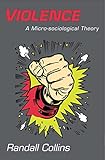Violence : A Micro-sociological Theory / Randall Collins.
Material type: TextPublisher: Princeton, NJ : Princeton University Press, [2009]Copyright date: ©2009Edition: Course BookDescription: 1 online resource (584 p.) : 53 halftones. 1 line illus. 4 tablesContent type:
TextPublisher: Princeton, NJ : Princeton University Press, [2009]Copyright date: ©2009Edition: Course BookDescription: 1 online resource (584 p.) : 53 halftones. 1 line illus. 4 tablesContent type: - 9780691143224
- 9781400831753
- 303.60973 22
- HM1121 .C64 2009
- online - DeGruyter
- Issued also in print.
| Item type | Current library | Call number | URL | Status | Notes | Barcode | |
|---|---|---|---|---|---|---|---|
 eBook
eBook
|
Biblioteca "Angelicum" Pont. Univ. S.Tommaso d'Aquino Nuvola online | online - DeGruyter (Browse shelf(Opens below)) | Online access | Not for loan (Accesso limitato) | Accesso per gli utenti autorizzati / Access for authorized users | (dgr)9781400831753 |
Browsing Biblioteca "Angelicum" Pont. Univ. S.Tommaso d'Aquino shelves, Shelving location: Nuvola online Close shelf browser (Hides shelf browser)

|

|

|

|

|

|

|
||
| online - DeGruyter This Time Is Different : Eight Centuries of Financial Folly / | online - DeGruyter Understanding Institutional Diversity / | online - DeGruyter The Best Laid Schemes : Selected Poetry and Prose of Robert Burns / | online - DeGruyter Violence : A Micro-sociological Theory / | online - DeGruyter Terror in Chechnya : Russia and the Tragedy of Civilians in War / | online - DeGruyter Richard Wagner and His World / | online - DeGruyter The Paris Letters of Thomas Eakins / |
Frontmatter -- Contents -- Illustrations and Tables -- Acknowledgments -- 1. The Micro-sociology of Violent Confrontations -- PART ONE. The Dirty Secrets of Violence -- 2. Confrontational Tension and Incompetent Violence -- 3. Forward Panic -- 4. Attacking the Weak: I. Domestic Abuse -- 5. Attacking the Weak: II. Bullying, Mugging, and Holdups -- PART TWO. Cleaned-up and Staged Violence -- 6. Staging Fair Fights -- 7. Violence as Fun and Entertainment -- 8. Sports Violence -- PART TREE. Dynamics and Structure of Violent Situations -- 9. How Fights Start, or Not -- 10. The Violent Few -- 11. Violence as Dominance in Emotional Attention Space -- 12. Epilogue: Practical Conclusions -- Notes -- References -- Index
restricted access online access with authorization star
http://purl.org/coar/access_right/c_16ec
In the popular misconception fostered by blockbuster action movies and best-selling thrillers--not to mention conventional explanations by social scientists--violence is easy under certain conditions, like poverty, racial or ideological hatreds, or family pathologies. Randall Collins challenges this view in Violence, arguing that violent confrontation goes against human physiological hardwiring. It is the exception, not the rule--regardless of the underlying conditions or motivations. Collins gives a comprehensive explanation of violence and its dynamics, drawing upon video footage, cutting-edge forensics, and ethnography to examine violent situations up close as they actually happen--and his conclusions will surprise you. Violence comes neither easily nor automatically. Antagonists are by nature tense and fearful, and their confrontational anxieties put up a powerful emotional barrier against violence. Collins guides readers into the very real and disturbing worlds of human discord--from domestic abuse and schoolyard bullying to muggings, violent sports, and armed conflicts. He reveals how the fog of war pervades all violent encounters, limiting people mostly to bluster and bluff, and making violence, when it does occur, largely incompetent, often injuring someone other than its intended target. Collins shows how violence can be triggered only when pathways around this emotional barrier are presented. He explains why violence typically comes in the form of atrocities against the weak, ritualized exhibitions before audiences, or clandestine acts of terrorism and murder--and why a small number of individuals are competent at violence. Violence overturns standard views about the root causes of violence and offers solutions for confronting it in the future.
Issued also in print.
Mode of access: Internet via World Wide Web.
In English.
Description based on online resource; title from PDF title page (publisher's Web site, viewed 30. Aug 2021)


